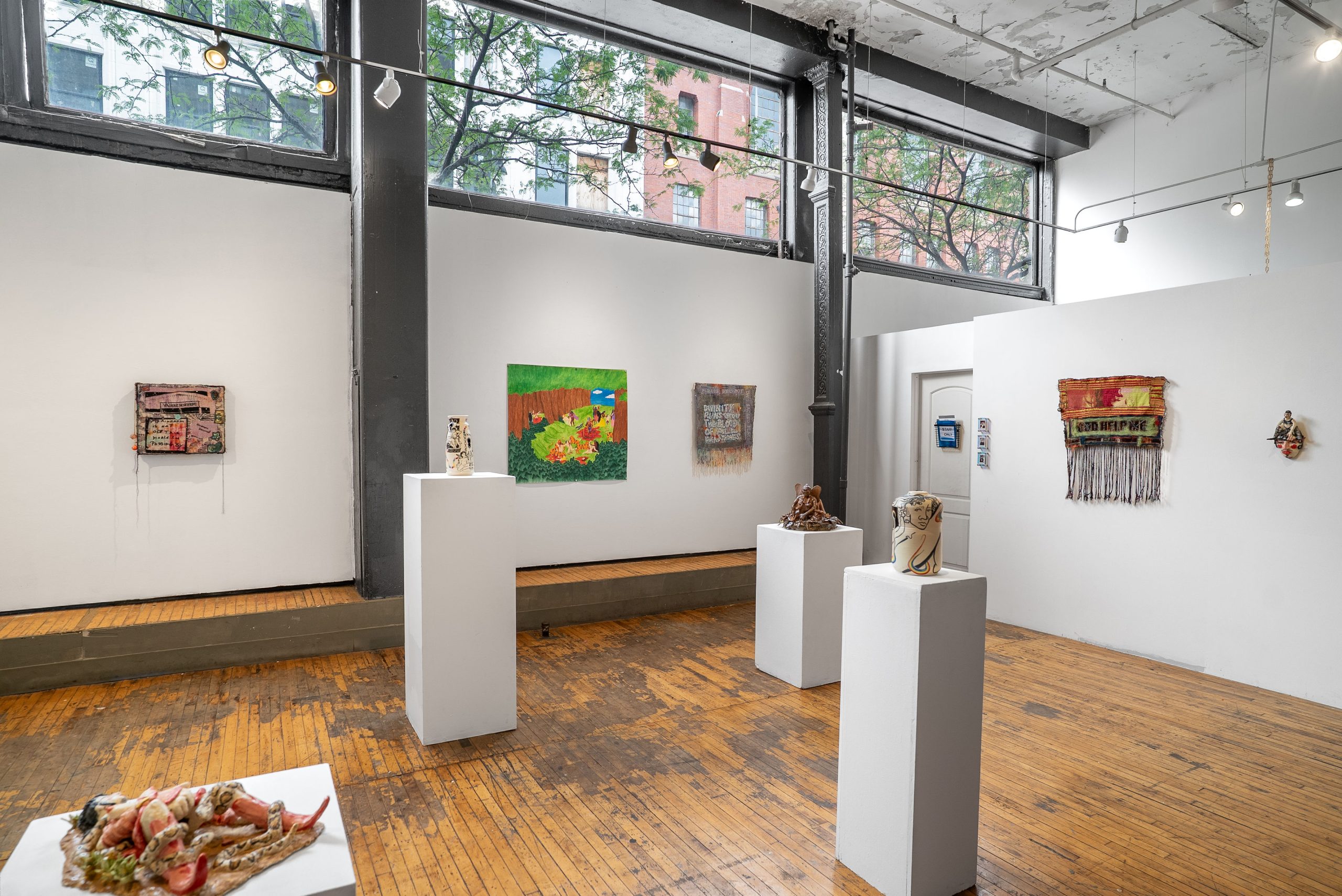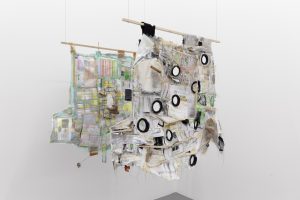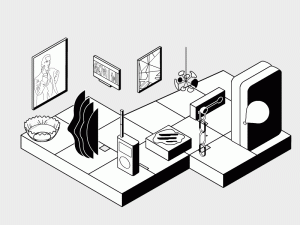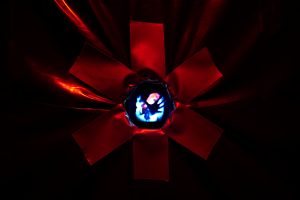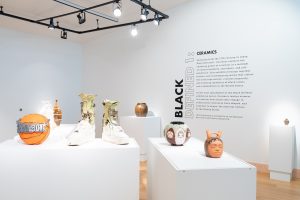Eden Through A Glory Hole, a group exhibit at the Chicago Art Department, titillates and gratifies the imagination with ecstatic queer and trans cosmologies. Vivid and sexy pleasures are on hand, like an underground Boschian wonderland with a promiscuous sense of spiritual vastness. The biblical Eden was an expulsion scene, but this exhibit refuses the terms of banishment and, by way of its myriad of literal and figurative glory holes, trespasses the rib’s psychic wound, reclaiming forbidden knowledge of trans bodies and sexuality as sacred.
Despite the US government’s fanatic attempts at censure and vilification, trans life cannot be legislated out of existence. We’ll best the Trump administration’s fascist wet dreams with our own imaginative sexual and mythological fantasies. The five featured artists, Mariposa Divina, Val Schlosberg, Tali Halpern, Alex Lecce, and Anwar Mahdi, draw on a reservoir of diverse mythological sources to enact and inhabit an Eden of their own: a gay ecosystem with a distinctly sensual and fable-like visual vocabulary, highlighting our persistence in queer life-worlds.
While there is substantial variegation in the artists’ approaches, a florid cross-pollination of motifs, text, and bright colors emerges in this pleasure garden across media, coming together as a poetic collective vision. For example, ceramic vessels by Val Schlosberg and “transculptures” by Mariposa Divina interweave across the center of the room like asters and goldenrods in a garden, staggered at various heights. This sense of commingling and invited participation within the gallery reminded me of cruising’s unexpected connection forming. Cruising, as featured artist Val Schlosberg describes in a co-authored essay in Make the Golf Course a Public Sex Forest, is a time-honored queer ritual of desire that encourages “using one’s sense and presence in a moment to embrace a shared living community.” Being aware of and recognizing one’s environment as a space of contact and flow means being alive to the always emergent possibilities of relationships built on surprise and wonder: Who might you encounter?
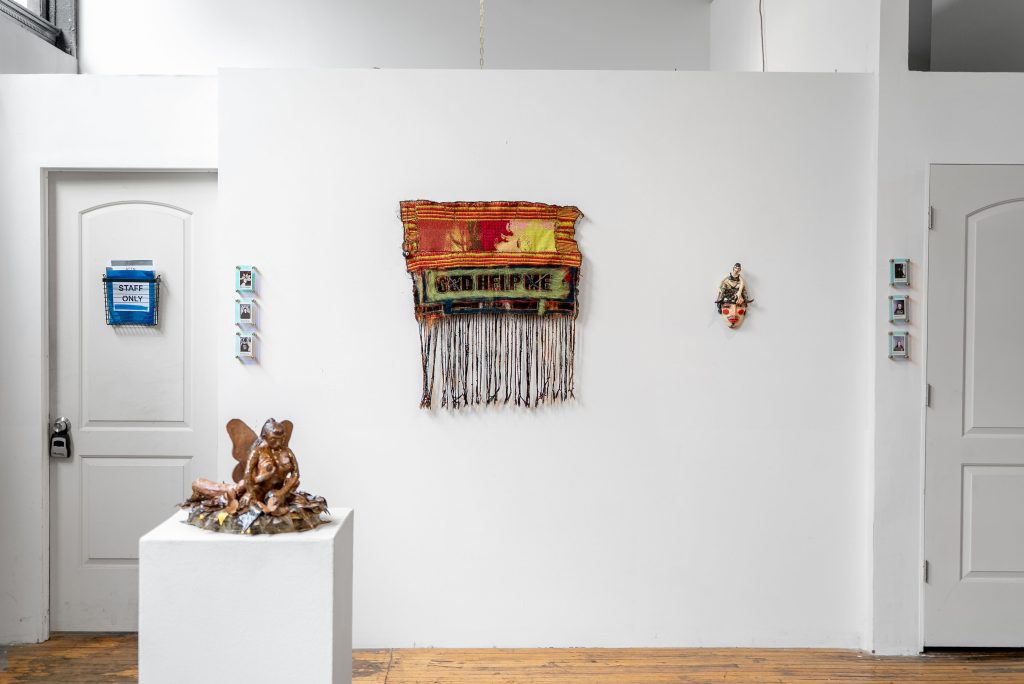
°°°
Mariposa Divina’s sapphic ceramic scenes caught beautifully stylized genderfluid freaks in various states of undress, glazed in luxuriating pastel colors. These transculptures, often set in repose with figures lying in the grass or with their ass out to the wind, are delightfully horny while also glamorously serene in their leisurely revelry. Almost always nipple out, sunning androgynously, decked from head to toe impeccably, with accessories like pointed red boots, arm warmers, a cropped tie-up lace cowboy vest, and harnesses. (Divina is also a singular fashion designer and stylist.)
There’s world-making in each fervid detail—from the gold folding of leaves to the texture of snakeskin, and even a standout pink nub of an orifice sticking out in a bronze-colored sculpture. The queer ornamental functions not only as decorative, but as a magnification: a maximalist triumph of dissociative flights of fancy. And so I pull out my notebook, start writing an ekphrastic poem:
ecstasy can be fatal
after Mariposa Divina’s Con Cuidado, Que Pica!
ecstasy left me for dead, writhing
on the desert floor, eyes closed in
paradise resting on a bed of cacti
sun swirling her red bedeviled tongues
inside my molten parts, which wandered
outside of me stirring up dust clouds
striated textures dissociating in the heat,
floating to higher dimensions of consciousness
each snakewoman’s reward back on earth
my fingernails dig into the temptation of silt
rewriting my scorched skin from underneath
until I am all sediment
what I meant to say:
death left me in ecstasy
In Las Lesbianas, another Divina sculpture, swans serenade two lovers frolicking in a park, their harnesses chained together, as if on their never-ending first date. (Was it, like mine once, a ride on the swan boats in Humboldt Park Lagoon?) It’s framed by two long tapered candles as if the piece were a ceremonial candelabra of T4T devotion, sanctifying queer intimacy. The sculpture Amigxs magnifies this feeling, featuring a couple fucking outdoors enveloped by large angelic butterfly wings. It is almost too beautiful to look at, and I feel for a moment as if I am intruding on a private moment. That spectacular quiet intimacy of outdoor sex feels holy, all-consuming in the grand scale of limbs interlacing with sky, earth. It’s not for nothing beloved queer film auteur Derek Jarman proclaimed that “for those in the know, the alfresco fuck is the original fuck,” in his diaries Modern Nature, teeming with cruising encounters in England’s gardens. He quipped, “Didn’t the Garden of Eden come before the house which hid our nakedness?”
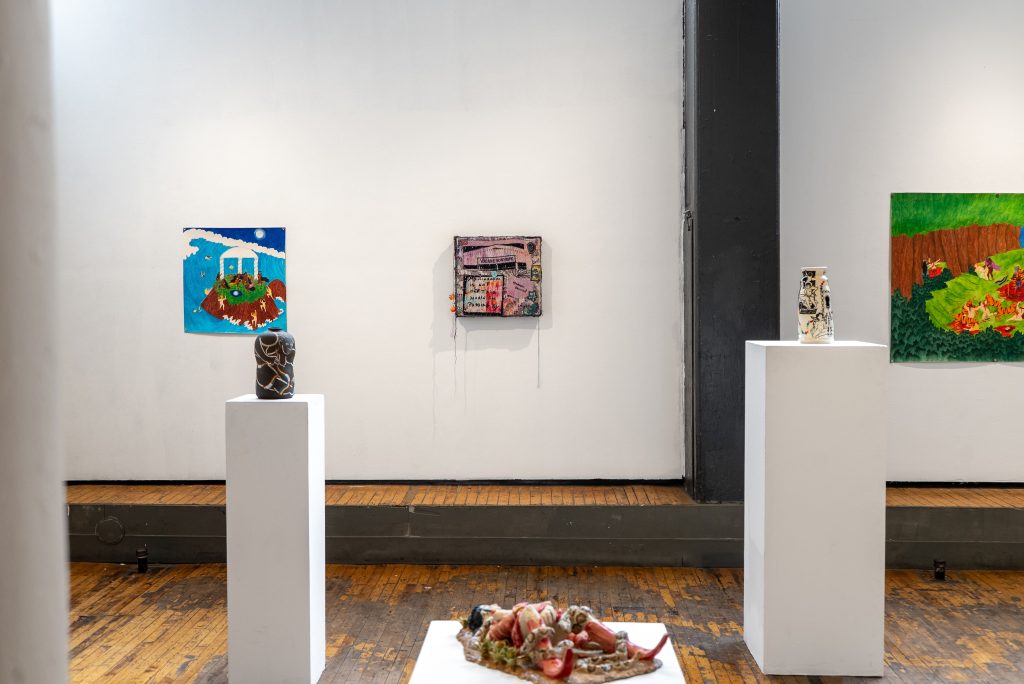
°°°
Perverse sacrament could also describe Val Schlosberg’s ceramic vessels, depicting blueprints for revolution. Scenes with leather pups and activists painted in black and white illustrative story-book style are framed by rainbow ribbons which quote tactics and insights from The Faggots and Their Friends Between the Revolutions by Larry Mitchell and Ned Asta as lovingly as holy scripture. This is my “alter book,” too; as it happened, I brought my copy for friends to write or draw inside. Schlosberg’s vessels contain keyholes through which you could peer into. In one jar, a secret message inside preserves faggot wisdom for those in the know: “The faggots cultivate beauty and harmony and peace because these are the states the men do not know about.” This is an insider message, a counterknowledge upheld as sacred wisdom. Pass by too quickly and you’d miss this message.
Prudent placement of another vessel allows for another keyhole to peek through to a message woven into one of Tali’s hanging fabric pieces: “My kingdom is out off this world I’m passing by.” This unexpected gesture and point of contact feels like a form of cross-pollination, an upholding of a peer’s contemporary words as sacred, too, crossed-out typo and all. The struck-through second “f” in “off,” a malapropism preserved in the art, glitchily suggests a secret second meaning: an alternate or underground worldmaking offsite, uncontained by the here and now of this world. That elsewhere might be the “NOWHERE” in the sign hanging in the center, which is the literal meaning of “utopia.”
°°°
Tali Halpern’s ripped-from-diary fiber art pieces shift the scene into domestic interiors, the only work in the show not set outdoors. These vulnerable dyed tapestries work in a rich symbolic lexicon of self-care, embroidered with piercing embellishments and layered collage elements which rip open an exhausted heart.
The Tracey Emin-esque diptyque bondage of self/yearning for former ignorance, sprawled open like two pages of a notebook, weaves in what seems to be a private journal entry handwritten in cursive like inflamed scars, introspectively wondering about dating struggles, the tireless hunt for validation, and sick of games of pretending. In the foreground on the recto side, a figure stripped down to their underwear kneels in hero pose, a river of blood racing from their neck in the alchemical form of ruby sequins, draping over their chest and down their thighs. On the facing page, a mirrored but inverted reflection hovers in suspension, almost symmetrical. I thought of this lacerated ghostly double as a representation of heartbreak’s déjà vu, the sense of familiar wounds freshly reopened. At the bottom, a running caption in cut-out letters “bitch I am TIRED of HEALIN.” Despite the display of self-harm, there was also a sense of triumph or vindication, not unlike Alex Lecce’s nod to Judith Beheading Holofernes across the room, I Am Not He.
Lecce’s triptych version, made androgynous and set in alien hues on a beach cove, is part of their “incarnation” series, which is painted on thrifted mirrors and portrays dream-like and emotionally rife scenes featuring mysterious creatures in the four different elements. There’s an element of tarot-like magic mysticism. Painted over, the glass surface of the mirrors transforms into a portal space; rather than reflecting reality, they now instead transport to fantastical elsewheres. Seeking out mythical elements in nature’s queer cavernous architectures, like caves or lagoon coves, here you’ll find unexpectedly bright alien blues, yellows, greens, and purples. As Lecce’s psychedelic portraiture style draws out limitless expanses and liminal thresholds, like infinite water swirls or looping constellations. I stare too deeply into the eddies and hear voices stirring up another poetic mood:
Evening’s trough aglow, holy
after Alex Lecce’s Reclamation
O insomniac voices
beamed thru my third eye
yell——ow!
Whoso swirls these waters ~ ~ ~
my cauterized lagoon cauldron
in solitude, dark reclaims infinite light
Collective psyche surrender
unzips horizon’s red mouths
radiant flotation devices
draining sky’s mosaic from below
fantasy’s undoing
bell——ow! ow!
Evening’s trough aglow,
holy sustenance
these cosmic secretions
unending archetypal elements
mystic plover, what will I find
when I tunnel thru these depths
Mirages are not mirrors
liminal thresholds? yes
yet what they show is truer:
kaleidoscopic secrets from beyond
gossip with the void—chimerical murmurings
nearly merging with our memories
°°°
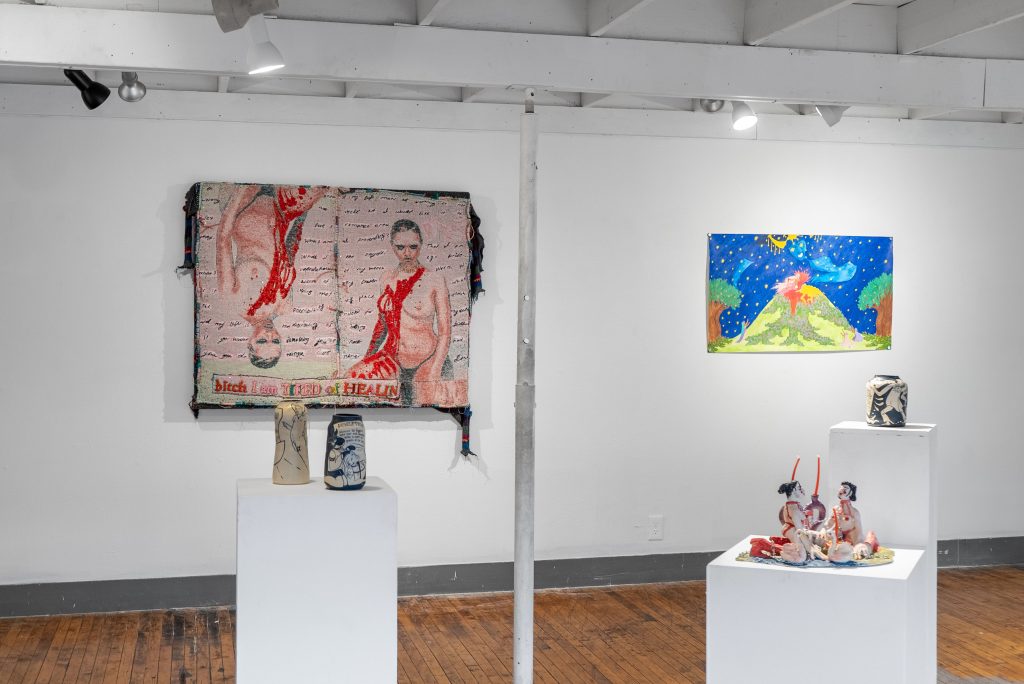
As a poet, I latch onto text in art, which is present in Halpern and Schlosberg’s works. I take notice of when title words show up, like how “through” is the only word from the exhibit title to appear in the show, and in two different works. Though seemingly understated, “through” functions unexpectedly as a key. In one of Val Schlosberg’s keyhole vessels, “through” offers a pathway: “TOGETHER I SEE A WAY THROUGH.” This quote from The Faggots and their Friends unfurls on a rainbow ribbon wrapping around the vessel, like a yellow brick road or a desire line, insisting on solidarity and community action to get “through” day-by-day oppression and find a way to collective liberation. “Through” appears in a second sense of a connecting through-line in Halpern’s beaded fabric piece, an aphorism in blue bubble text on royal purple suggests that “DIVINITY RUNS THROUGH THE BLOOD OF ALL LIVING THINGS,” pointing to a shared but under-acknowledged sacred quality which is all around.
And blood was all around, a motif in most of the artists’ work. As if we were peering into a “gory hole,” underscoring the ways that violence against queer people disrupts our world-making. This was particularly true of Anwar Madhi’s violently orgiastic garden scenes, illustrated in watercolor and colored pencil with details of classical architecture and mythology. In the Temple of Eros II: the architecture of the classical temple frames the action, including a delicious scene on the pediment showing trans women bent over in the throes of fucking each other, getting each other off. Glimpse through an ionic colonnade (a mostly unimpeded view) for voyeuristic entry into an expansive and verdant garden landscape of sexual and surreal pleasures. I’m pulled into the expressive range of emotions Mahdi captures; not just in the facial contortions of ecstasy, but also various body fluids—tears, cum, piss, blood—as a palette for articulating embodied feelings in their fullness.
The conflict in Mahdi’s illustrated worlds takes on an anti-colonial frame as brown women defend their homes from white women invaders. Nature is an anti-colonial force, powerfully on the side of Earth’s defenders. In the watercolor and colored pencil drawing The Thriae Summoning the Flood at the End of the World, three brown sister nymphs dance around a pool reflecting the full moon, summoning a tsunami wave to drown the naked white women who try to scale an island from the waters. Near them, another woman pisses on an invader. Distinct from the pleasurable piss play in its neighboring painting, this piss is weaponized, an expression of being pissed.
This alternating sense of bodily fluids expressing both rage and pleasure evokes Audre Lorde’s twin essays “The Uses of the Erotic” and “The Uses of Anger.” For Lorde, anger—specifically of women of color—is a clarifying source of information and energizing action. Likewise, Lorde reclaims the erotic as “a measure between the beginnings of our sense of self and the chaos of our strongest feelings,” a depth of feeling for what’s possible which feeds our sense of recognition and respect. Both are vital forces for our liberation; they are mutually co-constitutive.
°°°
I end my initial cruise around the gallery, having peeked at and scribbled half-illegible notes on the gallery checklist about the twenty-five works on display. Friends are now arriving at the opening, and I welcome the frivolity and lines of flirtatious glances that fill the room. My “alter book” passes between hands, even after I leave, and later, I hear secondhand about unexpected friend crossings and reunions, a birthday cake, an alphabet of mischief and eroticism. I’ll resist pouring the gossip into the review and let you imagine the ambience in the room, as we voyeurs crowded this perverted haven.
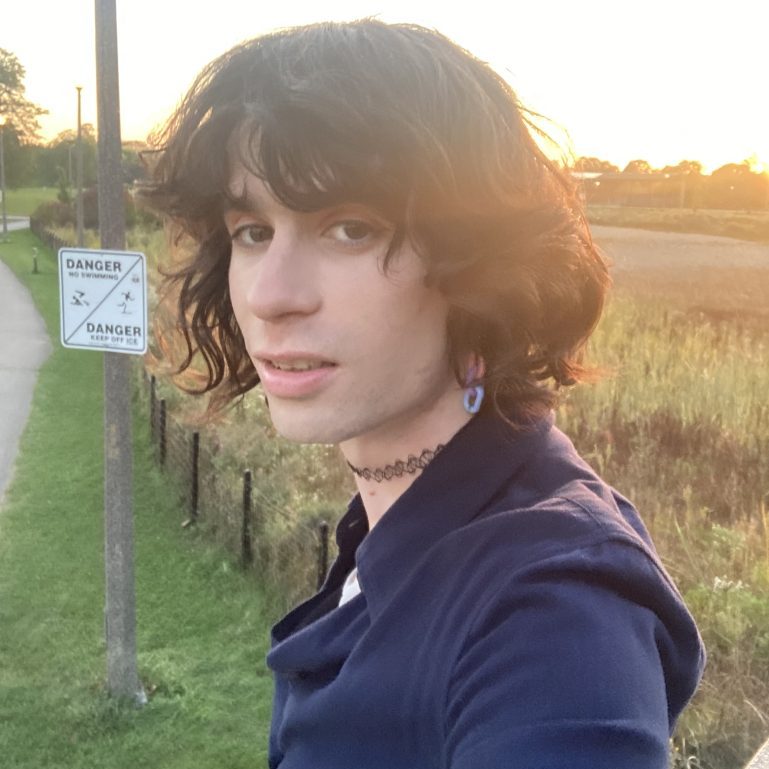
About the author: Noa Micaela Fields is a trans poet with hearing aids. She is the author of the poetry book E, forthcoming from Nightboat Books. She lives in Chicago, where she frequently organizes poetry readings, makes zines, and goes out dancing. www.noamicaelafields.com
